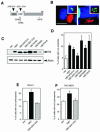Human papillomavirus type 16 E7 oncoprotein can induce abnormal centrosome duplication through a mechanism independent of inactivation of retinoblastoma protein family members
- PMID: 14581569
- PMCID: PMC254291
- DOI: 10.1128/jvi.77.22.12331-12335.2003
Human papillomavirus type 16 E7 oncoprotein can induce abnormal centrosome duplication through a mechanism independent of inactivation of retinoblastoma protein family members
Abstract
The human papillomavirus type 16 (HPV-16) E7 oncoprotein rapidly induces centrosome duplication errors in primary human cells, thereby increasing the propensity for multipolar mitoses, which can lead to chromosome missegregation and aneuploidy. We analyzed a series of HPV-16 E7 mutants and demonstrate that this biological activity of the E7 oncoprotein is mediated by sequences encompassing the core pRB binding site but is independent of its ability to inactivate the retinoblastoma tumor suppressor protein pRB and the related pocket proteins p107 and p130. In addition, interaction of E7 with the S4 subunit of the 26S proteasome and dysregulation of cdc25A transcription are also dispensable for the induction of centrosome duplication errors. Consistent with these results, expression of HPV-16 E7 induces abnormal centrosome duplication in a cell line that lacks functional pRB and in mouse embryo fibroblasts that are deficient for pRB, p107, and p130. These results demonstrate that the molecular mechanism whereby HPV-16 E7 induces centrosome duplication errors is independent of its ability to inactivate pRB, p107, and p130 or to interact with the S4 proteasome subunit.
Figures

Similar articles
-
Human papillomavirus type 16 E7 oncoprotein associates with the centrosomal component gamma-tubulin.J Virol. 2007 Dec;81(24):13533-43. doi: 10.1128/JVI.01669-07. Epub 2007 Oct 3. J Virol. 2007. PMID: 17913829 Free PMC article.
-
Degradation of the retinoblastoma tumor suppressor by the human papillomavirus type 16 E7 oncoprotein is important for functional inactivation and is separable from proteasomal degradation of E7.J Virol. 2001 Aug;75(16):7583-91. doi: 10.1128/JVI.75.16.7583-7591.2001. J Virol. 2001. PMID: 11462030 Free PMC article.
-
The E7 proteins of low- and high-risk human papillomaviruses share the ability to target the pRB family member p130 for degradation.Proc Natl Acad Sci U S A. 2006 Jan 10;103(2):437-42. doi: 10.1073/pnas.0510012103. Epub 2005 Dec 28. Proc Natl Acad Sci U S A. 2006. PMID: 16381817 Free PMC article.
-
Human papillomaviruses and centrosome duplication errors: modeling the origins of genomic instability.Oncogene. 2002 Sep 9;21(40):6241-8. doi: 10.1038/sj.onc.1205709. Oncogene. 2002. PMID: 12214255 Review.
-
Centrosomes, genomic instability, and cervical carcinogenesis.Crit Rev Eukaryot Gene Expr. 2003;13(1):9-23. doi: 10.1615/critreveukaryotgeneexpr.v13.i1.20. Crit Rev Eukaryot Gene Expr. 2003. PMID: 12839094 Review.
Cited by
-
Basics of tumor development and importance of human papilloma virus (HPV) for head and neck cancer.GMS Curr Top Otorhinolaryngol Head Neck Surg. 2012;11:Doc09. doi: 10.3205/cto000091. Epub 2012 Dec 20. GMS Curr Top Otorhinolaryngol Head Neck Surg. 2012. PMID: 23320061 Free PMC article.
-
Such small hands: the roles of centrins/caltractins in the centriole and in genome maintenance.Cell Mol Life Sci. 2012 Sep;69(18):2979-97. doi: 10.1007/s00018-012-0961-1. Epub 2012 Mar 30. Cell Mol Life Sci. 2012. PMID: 22460578 Free PMC article. Review.
-
Genomic instability and cancer: lessons learned from human papillomaviruses.Cancer Lett. 2011 Jun 28;305(2):113-22. doi: 10.1016/j.canlet.2010.10.013. Epub 2010 Nov 13. Cancer Lett. 2011. PMID: 21075512 Free PMC article. Review.
-
A clinical overview of centrosome amplification in human cancers.Int J Biol Sci. 2011;7(8):1122-44. doi: 10.7150/ijbs.7.1122. Epub 2011 Oct 16. Int J Biol Sci. 2011. PMID: 22043171 Free PMC article. Review.
-
Centrosomal Nlp is an oncogenic protein that is gene-amplified in human tumors and causes spontaneous tumorigenesis in transgenic mice.J Clin Invest. 2010 Feb;120(2):498-507. doi: 10.1172/JCI39447. Epub 2010 Jan 19. J Clin Invest. 2010. PMID: 20093778 Free PMC article.
References
-
- Baker, S. J., S. Markowitz, E. R. Fearon, J. K. Willson, and B. Vogelstein. 1990. Suppression of human colorectal carcinoma cell growth by wild-type p53. Science 249:912-915. - PubMed
-
- Berezutskaya, E., and S. Bagchi. 1997. The human papillomavirus E7 oncoprotein functionally interacts with the S4 subunit of the 26 S proteasome. J. Biol. Chem. 272:30135-30140. - PubMed
-
- Boyer, S. N., D. E. Wazer, and V. Band. 1996. E7 protein of human papilloma virus-16 induces degradation of retinoblastoma protein through the ubiquitin-proteasome pathway. Cancer Res. 56:4620-4624. - PubMed
-
- Chen, P. L., Y. M. Chen, R. Bookstein, and W. H. Lee. 1990. Genetic mechanisms of tumor suppression by the human p53 gene. Science 250:1576-1580. - PubMed
Publication types
MeSH terms
Substances
Grants and funding
LinkOut - more resources
Full Text Sources

